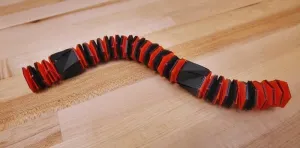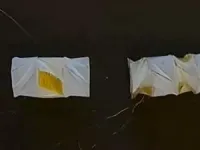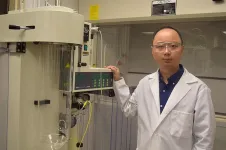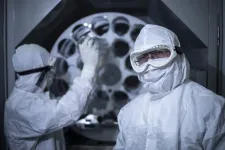(Press-News.org) Engineers at Princeton and North Carolina State University have combined ancient paperfolding and modern materials science to create a soft robot that bends and twists through mazes with ease.
Soft robots can be challenging to guide because steering equipment often increases the robot’s rigidity and cuts its flexibility. The new design overcomes those problems by building the steering system directly into the robot’s body, said Tuo Zhao, a postdoctoral researcher at Princeton.
In an article published May 6 in the journal PNAS, the researchers describe how they created the robot out of modular, cylindrical segments. The segments, which can operate independently or join to form a longer unit, all contribute to the robot’s ability to move and steer. The new system allows the flexible robot to crawl forward and reverse, pick up cargo and assemble into longer formations.
“The concept of modular soft robots can provide insight into future soft robots that can grow, repair, and develop new functions,” the authors write in their article.
Zhao said the robot’s ability to assemble and split up on the move allows the system to work as a single robot or a swarm.
“Each segment can be an individual unit, and they can communicate with each other and assemble on command,” he said. “They can separate easily, and we use magnets to connect them.”
Zhao works in Glaucio Paulino’s lab in the Department of Civil and Environmental Engineering and the Princeton Materials Institute. Paulino, the Margareta Engman Augustine Professor of Engineering, has created a body of research that applies origami to a wide array of engineering applications from medical devices to aerospace and construction.
“We have created a bio-inspired plug-and-play soft modular origami robot enabled by electrothermal actuation with highly bendable and adaptable heaters,” Paulino said. “This is a very promising technology with potential translation to robots that can grow, heal, and adapt on demand.”
In this case, the researchers began by building their robot out of cylindrical segments featuring an origami form called a Kresling pattern. The pattern allows each segment to twist into a flattened disk and expand back into a cylinder. This twisting, expanding motion is the basis for the robot’s ability to crawl and change direction. By partially folding a section of the cylinder, the researchers can introduce a lateral bend in a robot segment. By combining small bends, the robot changes direction as it moves forward.
One of the most challenging aspects of the work involved developing a mechanism to control the bending and folding motions used to drive and steer the robot. Researchers at North Carolina State University developed the solution. They used two materials that shrink or expand differently when heated (liquid crystal elastomer and polyimide) and combined them into thin strips along the creases of the Kresling pattern. The researchers also installed a thin stretchable heater made of silver nanowire network along each fold. Electrical current on the nanowire heater heats the control strips, and the two materials’ different expansion introduces a fold in the strip. By calibrating the current, and the material used in the control strips, the researchers can precisely control the folding and bending to drive the robot’s movement and steering.
“Silver nanowire is an excellent material to fabricate stretchable conductors. Stretchable conductors are building blocks for a variety of stretchable electronic devices including stretchable heaters. Here we used the stretchable heater as the actuation mechanism for the bending and folding motions” said Yong Zhu, the Andrew A. Adams Distinguished Professor in the Department of Mechanical and Aerospace Engineering at N.C. State and one of the lead researchers.
Shuang Wu, a postdoctoral researcher in Zhu’s lab, said the lab’s previous work used the stretchable heater for continuously bending a bilayer structure. “In this work we achieved localized, sharp folding to actuate the origami pattern. This effective actuation method can be generally applied to origami structures (with creases) for soft robotics,” Wu said.
The researchers said that the current version of the robot has limited speed, and they are working to increase the locomotion in later generations.
Zhao said the researchers also plan to experiment with different shapes, patterns, and instability to improve both the speed and the steering.
Modular Multi-degree-of-freedom Soft Origami Robots with Reprogrammable Electrothermal Actuation was published online May 6 in the Proceedings of the National Academy of Sciences. Support for the research was provided in part by the National Science Foundation and the National Institutes of Health.
END
Caterbot? Robatapillar? It crawls with ease through loops and bends
2024-05-06
ELSE PRESS RELEASES FROM THIS DATE:
Geologists, biologists unearth the atomic fingerprints of cancer
2024-05-06
Scientists at the University of Colorado Boulder and Princeton University have, for the first time, employed a tool often used in geology to detect the atomic fingerprints of cancer.
In a case of medicine meets earth science, the researchers discovered that cancer cells may be made from a different assortment of hydrogen atoms than healthy tissue. The findings could give doctors new strategies for studying how cancer grows and spreads—and may even, one day, lead to new ways to spot cancer early on in the body.
The team, led by CU Boulder geochemist Ashley Maloney, will publish its findings this week ...
Purdue pharmacy researcher receives $2.4 million NIH grant to fight antimicrobial-resistant lung infections
2024-05-06
WEST LAFAYETTE, Ind. — Qi “Tony” Zhou, a researcher in Purdue University’s College of Pharmacy has received a $2.4 million grant from the National Institutes of Health to fight lung infections that have established a resistance to antimicrobial drugs.
Zhou is an associate professor in the Department of Industrial and Molecular Pharmaceutics, a Faculty Scholar and a faculty member of the Purdue Institute for Drug Discovery and the Purdue Institute of Inflammation, Immunology and Infectious Disease. He leads a team of multinational experts from Australia, Thailand and the United States in developing novel, patent-pending ...
The Clues for Cleaner Water
2024-05-06
Researchers at the University of Pittsburgh and Drexel University in Philadelphia, along with Brookhaven National Laboratory, are working to solve a multipart mystery to make water disinfection treatments more sustainable.
Scalable electrochemical ozone production (EOP) technologies to disinfect dirty water may someday replace centralized chlorine treatments used today, whether in modern cities or remote villages. However, little is understood about EOP at the molecular level and how technologies that make it possible can be made to be efficient, economical, and sustainable.
Their research, “Interplay between Catalyst Corrosion and Homogeneous Reactive Oxygen Species ...
New $14.5 million center to help US Navy overcome emerging challenges
2024-05-06
Images
The U.S. Office of Naval Research is tapping academic expertise at the University of Michigan to solve current and future problems, Secretary of the Navy Carlos Del Toro announced during his visit to campus over graduation weekend.
The $14.5M Center for Naval Research and Education will also help train an engineering research community familiar with naval and marine applications.
"I am incredibly proud of the partnership between the University of Michigan and the Department of the Navy. Michigan is a key teammate in rebuilding our shipbuilding industry and restoring the comprehensive—commercial ...
Now available from Penn Nursing: innovative, online psychedelic course
2024-05-06
PHILADELPHIA (May 6, 2024) – Penn Nursing is proud to launch a groundbreaking new online course – Educating Nurses in Psychedelic Assisted Therapy – via Open Canvas. This free comprehensive course is designed to prepare nursing professionals for the pioneering field of psychedelic assisted therapy (PAT), aligning with the latest advancements in mental health treatment and Penn Nursing's commitment to social justice in healthcare.
With this new modality of care on the horizon, the need for well-educated, ...
Greet receives funding for Abstraction in the Andes, 1950 - 1970
2024-05-06
Michele Greet, Director, Art History Program, received funding for: “Abstraction in the Andes, 1950-1970.”
She will examine the emergence of abstract painting in Andean countries (Peru, Ecuador, and Bolivia) in the 1950s and 1960s. She will explore artists’ newfound interest in pre-Columbian art as source material as well as the circulation of ideas from Europe and the United States.
Although abstract art rapidly gained acceptance throughout Latin America after World War II, until recently, studies of abstract painting in the region have focused on the geometric styles that emerged in Brazil, Argentina, and Venezuela. Different variants of abstraction ...
Mindfulness training enhances opioid addiction treatment
2024-05-06
Supplementing standard opioid addiction treatment with Mindfulness Oriented Recovery Enhancement (MORE) — an intervention that incorporates mindfulness training, savoring skills, and cognitive reappraisal — cuts program dropout rates by 59 percent and relapses by 42 percent, according to Rutgers-led research.
These trial results come from Rutgers Health amid unprecedented opioid abuse. An estimated 10 million Americans misuse opioids or have opioid use disorder, while annual overdose deaths have exceeded 80,000.
Treatment with methadone or buprenorphine – alone or in combination with cognitive behavioral therapy – is imperfect. Half ...
Using advanced genetic techniques, scientists create mice with traits of Tourette disorder
2024-05-06
In research that may be a step forward toward finding personalized treatments for Tourette disorder, scientists at Rutgers University–New Brunswick have bred mice that exhibit some of the same behaviors and brain abnormalities seen in humans with the disorder.
As reported in the Proceedings of the National Academy of Sciences, the researchers, using a technique known as CRISPR/Cas9 DNA editing that selectively modifies the DNA of living organisms, inserted the same genetic mutations found in humans with Tourette disorder into the corresponding genes in mouse embryos. After the mice were born, the scientists observed their behavior compared with littermates without the ...
3D video conferencing tool lets remote user control the view
2024-05-06
ITHACA, N.Y. -- Collaborating on a physical object when two people aren’t in the same room can be extremely challenging, but a new remote conferencing system allows the remote user to manipulate a view of the scene in 3D, to assist in complex tasks like debugging complicated hardware.
The system, called SharedNeRF, combines two graphics rendering techniques – one that is slow and photorealistic, and another that is instantaneous but less precise – to help the remote user experience ...
The Ottawa Hospital is expanding life-saving biotherapeutics research and manufacturing to its new campus thanks to $59 million grant
2024-05-06
The Ottawa Hospital is receiving $59 million to boost Canada’s capacity to develop and manufacture life-saving biotherapeutics, including vaccines, gene therapies and cell therapies. Most of the funding ($47 million) will support the construction and operation of a world-class biomanufacturing facility at The Ottawa Hospital’s new campus, while the remainder will enable harmonization and cooperation across six Canadian biomanufacturing facilities.
The funding is part of a $115 million investment from the Government of Canada in the Canadian Pandemic ...




